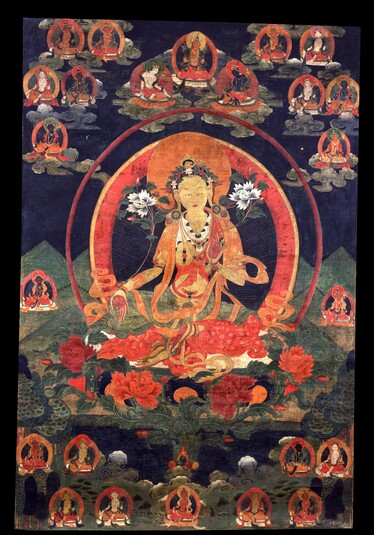
Item: Tara (Buddhist Deity) - (Atisha, 21 Taras)
| Origin Location | Tibet |
|---|---|
| Date Range | 1700 - 1799 |
| Lineages | Uncertain |
| Size | 114.30x76.20cm (45x30in) |
| Material | Ground Mineral Pigment, Raised Gold on Cotton |
| Collection | Rubin Museum of Art |
| Catalogue # | acc.# P1998.7.1 |
The Bodhisattva Tara (Tibetan: drol ma, English: Saviouress) and the 21 emanations from the tradition of Lord Atisha.
Golden in colour with one face and two hands, the right is extended in the mudra of supreme generosity while holding the stem of a blue utpala flower. The left is held at the heart in the mudra of blessing and holds the stem of another blue utpala blossom. The hair is tied in a topknot with some falling loose, adorned with a tiara of flowers, gold and jewels, earrings, necklaces and bracelets. Wearing silk - flowing in a variety of colours and a lower garment of green a red. In a relaxed posture with the right leg extended, the left drawn up, she is seated on a moon disc and multi-coloured lotus seat atop a stem rising from a lotus pond. Spheres of separated lights in circular radiating patterns emanate from her body.
At the top center sits the bodhisattva Manjushri , orange, with the hands in the Dharma Teaching mudra holding the stems of two flower blossoms supporting a sword and book. At the left is the bodhisattva Padmapani Avalokiteshvara, white, with two hands, holding the stem of a lotus blossom in the left; seated in a relaxed posture. At the right is the peaceful bodhisattva Vajrapani, blue, holding the stem of a lotus blossom supporting a vajra sceptre. Collectively they are known as the 'Lords of the Three Families.'
Surrounding the central Tara figure are the 21 emanations each with one face and two hands holding a vase in the extended right hand and the stem of a flower blossom to the heart with the left. The colour for each varies according to the activity and function of the particular Tara emanation. Generally they are white for peaceful activities, yellow for activities of increase, red for powerful activities and blue-black for wrathful activities. The set of 21 Taras arise from the Kriya Tantra of the 'Twenty-one Praises of Tara' spoken by the buddha Samantabhadra. The specific iconographic characteristics represented, such as the assortment of colours, single face, two hands, the vase in the right and flower in the left, are from the tradition of Lord Atisha (982-1054).
Tara is a completely enlightened buddha who had previously promised to appear, after enlightenment, in the form of a female bodhisattva and goddess for the benefit of all beings. Practiced in all Schools of Tibetan Buddhism her various forms are found in all classes of tantra - Nyingma and Sarma. Her 10 syllable mantra and the short tantra are memorized and popularly recited by all Tibetans from the time of early childhood. Aside from the special activities of the 21 forms her primary activity is to protect from the 8 and 16 fears.
Jeff Watt 10-98
From the Tantra manual known as the Twenty-One Praises of Tara spoken by the Buddha comes the system of practice with twenty-one forms, cryptically described, one for each verse of the Praise. Each of the forms has a specific color and accomplishes a specific activity or human need. Based on that original source manual there are three well-known and distinct lineages of interpretation, the Kashmiri Pandit Suryagupta, the Bengali scholar Atisha, and the lineage of the Tibetan teacher Longchenpa. These three lineages do not share the same iconographic characteristics. In the Atisha system, represented in this painting, all of the Taras appear in the same basic posture and differ only in the color of the body.
The principal form of Tara is always described as being green in color. Paintings with the subjects treated with gold paint, or leaf, are the result of the donor of the painting wishing to increase the personal amount of merit in creating such a religious icon.
Jeff Watt 5-2005
Exhibition: Female Buddhas at RMA
Publications
Publication: Worlds of Transformation
Thematic Sets
Buddhist Deity: Tara Main Page
Tibet: Amdo, Paintings (East Tibet)
Buddhist Deity: Tara (Atisha Tradition)
Collection of Rubin Museum of Art: Painting Gallery 5
Buddhist Deity: Tara Masterworks
Buddhist Deity: Tara, Twenty-one Taras (Atisha, Single Composition)
Buddhist Deity: Tara Source Texts
Buddhist Deity: Tara, Green (Golden Coloured)
Buddhist Deity: Tara, Green (Red Palms)
Buddhist Deity: Tara, Twenty-one Taras Main Page
Buddhist Deity: Tara, Green (Painting Masterworks)
Buddhist Deity: Tara, Twenty-one Taras (Masterworks)
